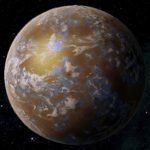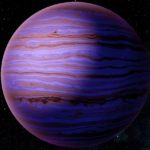System Specs:
- Stellar Mass: 0.82 Sol Masses
- Stellar Class: G
- Luminosity: N/A Sol
- Planets: 4
- Moons: > 1
- Asteroid Belts: 0
- Asteroids: 0
- Objects: 0

Schwarzschild has numerous indications of an advanced spacefaring civilization that lived here 20 to 40 million years ago. This civilization was apparently wiped out by orbital bombardment from dreadnought-class kinetic weapons.
Little else remains except moderate amounts of resources and element zero in Etamis.
–
Planets Directory:
- Atahil
- Etamis
- Linossa
- Rihali
–
Atahil:

- Orbital Distance: 0.9 AU
- Orbital Period: 1 Earth-year
- Keplerian Ratio: 0.729
- Radius: 5,230 km
- Day Length: 28.8 Earth-hours
- Atmospheric Pressure: 62 atm
- Surface Temp: 348 °C
- Surface Gravity: 0.79 g
- Mass: 0.527 Earth-masses
A typical Venusian “greenhouse” world, Atahil is only of note for a few scattered craters. Though flattened by millions of years of high pressure, the marks of orbital bombardment strikes are unmistakable. It is generally accepted among academics that whoever hailed from or settled Schwarzschild’s second planet, Etamis, must have had outposts on Atahil as well.
–
Etamis:

- Orbital Distance: 1.35 AU
- Orbital Period: 1.6 Earth-years
- Keplerian Ratio: 0.961
- Radius: 9,577 km
- Day Length: 51.6 Earth-hours
- Atmospheric Pressure: 0.2 atm
- Surface Temp: −49.6 °C
- Surface Gravity: 3.4 g
- Mass: 7.609 Earth-masses
Etamis is a super-terrestrial world a third larger than Earth. It is in a “post-garden” state that clearly shows evidence of attack from space. While now waterless, the shores of former oceans show patterns of cratering too regular to be anything but saturation bombardment by dreadnought-class kinetic weapons. Although it is unclear how, most of the atmosphere has been lost.
Archeologists have found little of note. It appears that all settled regions were touched by the global bombardment. The few relics found suggest an advanced spacefaring culture thrived on the world somewhere between from 20 and 40 million years ago. The level of antiquity makes it impossible to estimate the world’s former population, or guess whether it was the race’s homeworld or a colony.
–
Linossa:

- Orbital Distance: 3.34 AU
- Orbital Period: 6.8 Earth-years
- Keplerian Ratio: 0.806
- Radius: 55,806 km
- Day Length: 17.8 Earth-hours
- Atmospheric Pressure: N/A atm
- Surface Temp: N/A °C
- Surface Gravity: N/A g
- Mass: N/A Earth-masses
Linossa is a hydrogen-helium gas giant. It is surrounded by several thin rings of debris. Analysis of this debris has been difficult due to extreme age and fragility, but several apparently nano-manufactured materials have been identified. The leading theory is that the inhabitants of Etamis mined the atmosphere for helium-3.
–
Rihali:

- Orbital Distance: 6.34 AU
- Orbital Period: 17.9 Earth-years
- Keplerian Ratio: 0.795
- Radius: 70,778 km
- Day Length: 15.4 Earth-hours
- Atmospheric Pressure: 1.81 atm
- Surface Temp: N/A °C
- Surface Gravity: N/A g
- Mass: N/A Earth-masses
- Satellites: > 1
Rihali is a typical hydrogen-helium gas giant. It is notable because none of its moons is larger than 12 kilometers in diameter, a rare trait among the charted gas giants of the galaxy.
–
–
video





